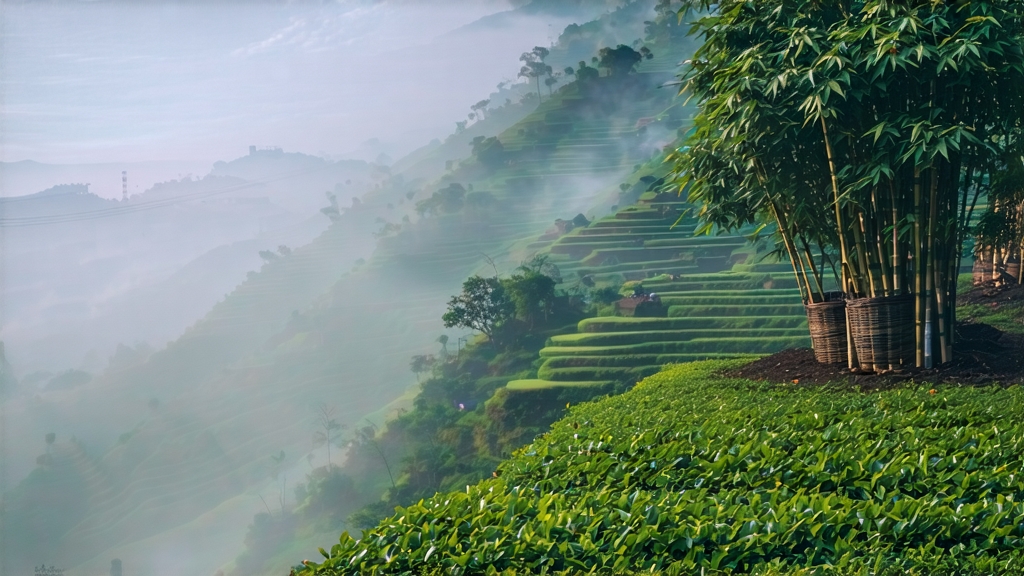
If green tea is China’s delicate watercolor and pu-erh its slow-aged oil painting, then Phoenix Dancong occupies the realm of perfumed chamber music—layered, lingering, and capable of shifting its melody with every steeping. Hailing from the phoenix-shaped ridges of Feng Huang (Phoenix) Mountain in northern Guangdong, this oolong family is treasured for its ability to mimic flowers, fruits, honey, spices, and even tropical cocktails, all without a single additive. To understand Dancong is to listen to centuries of Hakka and She minority farmers coaxing terroir into cupped fragrance, one charcoal ember at a time.
Historical echoes
Tea scholars generally agree that the first deliberately cultivated tea gardens on Phoenix Mountain appeared during the Song dynasty (960-1279 CE). Imperial tribute lists from 1118 record “Feng Huang Ming Cha,” and a 1537 county gazetteer already distinguishes “Dancong” trees—literally “single-bush” plantings that were individually marked, harvested, and processed to preserve their unique aromatics. When the young Kangxi Emperor tasted a particularly floral lot in 1687, he supposedly praised its “mountain bones and floral soul,” giving the tea unofficial court status. Maritime trade routes of the eighteenth century carried Dancong to Southeast Asia where it became the breakfast cup of choice in Chaozhou emigrant communities, thereby safeguarding both cultivars and brewing ritual abroad.
Micro-terroir and cultivar mosaic
Phoenix Mountain rises abruptly from the subtropical lowlands to 1,498 m, creating a staircase of misty mini-climates. Granitic soils, diurnal swings of 10 °C, and year-round fog slow leaf growth, condensing sugars and aromatics. Within this 200 km² core zone growers recognize three altitudinal bands: low (100-400 m), mid (400-800 m), and high mountain (800 m+). Only the latter earns the coveted “Shan Cha” (mountain tea) label, fetching prices comparable to top Burgundy crus. Centuries of massal selection—taking cuttings from an outstanding mother tree—have produced a living library of over 80 aromatic profiles. The most famous include:
• Honey-orchid (Mi Lan Xiang) – lychee-like sweetness with a honeysuckle tail
• Almond fragrance (Xing Ren Xiang) – marzipan and toasted nut notes
• Yellow gardenia (Huang Zhi Xiang) – creamy, almost custardy gardenia
• Ginger flower (Jiang Hua Xiang) – tingling, spicy finish reminiscent of fresh ginger
• Night-blooming jasmine (Mo Li Xiang) – cool, high-pitched floral lift
Each “fragrance type” is clonally propagated, yet subtle differences in elevation, solar hours, and even the bamboo species used for firing can tilt the cup toward peach, magnolia, or cinnamon.
Crafting the fragrance: a ten-act play
- Picking: Only the middle three leaves plus a bud are plucked when the morning dew just lifts, usually between 9 a.m. and noon to balance moisture and aroma precursors.
- Solar withering: Leaves are spread on bamboo screens under 70 % shade cloth for 20-40 min, softening cell walls and initiating enzymatic oxidation.
- Indoor withering: The trays rest on racks in an airy loft for 4-6 h, turned every hour to evenly redistribute moisture.
- Hand bruising: The most laborious step. Pairs of workers rhythmically toss the leaves into the air, allowing them to land on the bamboo tray; the gentle impact ruptures membranes, releasing green-leaf volatiles and jump-starting oxidation. This is repeated 5-7 times over 3 h.
- Oxidation arrest: When the leaf edge turns 30 % reddish-brown and the aroma shifts from grassy to peachy, the leaves are tumbled into a 230 °C drum roaster for 4 min, killing the enzymes and locking in the signature bouquet.
- Rolling: A light mechanical kneading forms the trademark strip shape while preserving tip integrity.
- First baking: 80 °C for 2 h reduces moisture to 20 %, stabilizing the leaf for sorting.
- Stem picking: Women armed with tweezers remove old stems and yellow leaves, ensuring visual uniformity.
- Charcoal baking: The soul of Dancong. Using 30-year-old